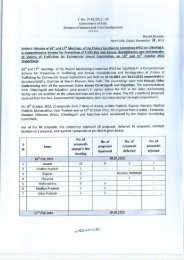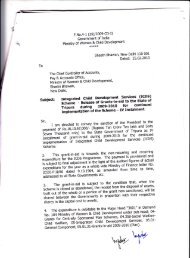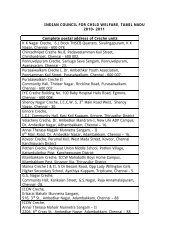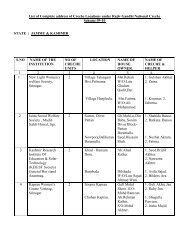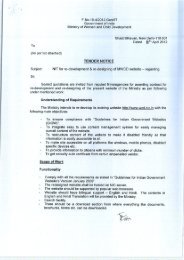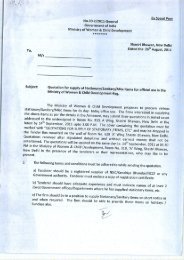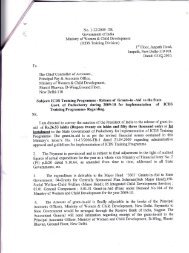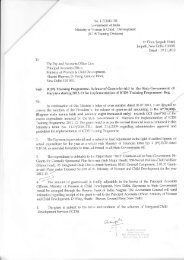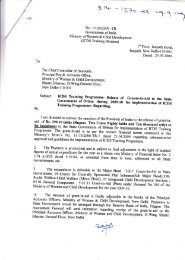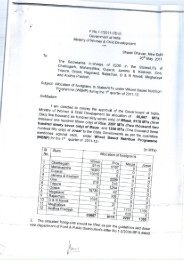COVER HINDI - Ministry of Women and Child Development
COVER HINDI - Ministry of Women and Child Development
COVER HINDI - Ministry of Women and Child Development
- TAGS
- hindi
- ministry
- wcd.nic.in
You also want an ePaper? Increase the reach of your titles
YUMPU automatically turns print PDFs into web optimized ePapers that Google loves.
Gender Budgeting<br />
- Budgeting for Gender Equity<br />
6.1 The goals <strong>of</strong> human development are closely<br />
intertwined with development <strong>and</strong> empowerment <strong>of</strong><br />
women, who, as an independent group constitute about<br />
496 million (2001 Census) representing 48% <strong>of</strong> the total<br />
population in the country. They comprise not only the<br />
valuable human resources <strong>of</strong> the country but their socio<br />
economic development sets the pace for sustainable growth<br />
<strong>of</strong> the rest <strong>of</strong> the economy.<br />
6.2 However, the reality is that women face disparities<br />
in access to <strong>and</strong> control over resources. These disparities<br />
get reflected in important parameters like health, nutrition,<br />
literacy, educational attainments, skill levels, occupational<br />
status etc. The poor status <strong>and</strong> value attached to women is<br />
reflected in the fact that the female sex ratio for 0-6 age<br />
group declined steeply from 945 in 1991 to 927 in 2001<br />
implying that millions <strong>of</strong> girls went missing in just a<br />
decade.<br />
6.3 There are a number <strong>of</strong> gender specific barriers,<br />
which prevent women from gaining access to their rightful<br />
share in the flow <strong>of</strong> public goods <strong>and</strong> services. Unless these<br />
gender requirements <strong>and</strong> their felt needs are incorporated<br />
<strong>and</strong> mainstreamed in the planning <strong>and</strong> development<br />
process it is apprehended that the fruits <strong>of</strong> economic growth<br />
are likely to completely bypass a significant section <strong>of</strong> the<br />
country’s population which does not augur well for the<br />
future growth <strong>of</strong> the economy.<br />
6.4 The planning process in the country had recognized<br />
this fact, but it is only in the last two decades has there<br />
been an explicit strategy to tackle gender related issues in<br />
a systematic manner by introducing an element <strong>of</strong> gender<br />
sensitivity in allocation <strong>of</strong> resources for women by<br />
identifying women beneficiary oriented schemes <strong>of</strong> various<br />
sectors, propagating the <strong>Women</strong>’s Component Plan (WCP)<br />
to ensure not less that 30% <strong>of</strong> the funds / benefits flow to<br />
women as well as encouraging Gender Budgeting to be<br />
applied in all sectors. The Approach Paper to the Eleventh<br />
CHAPTER-6<br />
Plan specifically states that ‘gender equity requires<br />
adequate provisions to be made in policies <strong>and</strong> schemes<br />
across Ministries <strong>and</strong> Departments . It also entails strict<br />
adherence to gender budgeting across the board’<br />
6.5 The importance <strong>of</strong> Gender Budgeting has been<br />
stressed time <strong>and</strong> again in different forums. To provide<br />
further impetus to this objective, the Finance Minister in<br />
2004-05 had m<strong>and</strong>ated the setting up <strong>of</strong> Gender Budgeting<br />
Cells in all Ministries/ Departments <strong>and</strong> highlighted the<br />
perceived need for budget data to be presented in a manner<br />
that brought out the gender sensitiveness <strong>of</strong> the budgetary<br />
allocations.. This was followed by a more emphatic<br />
commitment in the budget speech <strong>of</strong> 2005-06, wherein<br />
the budgetary allocations under 10 Dem<strong>and</strong>s for Grant<br />
estimated at Rs. 14379 crore were shown in a separate<br />
statement as a part <strong>of</strong> the Gender Budgeting exercise. The<br />
2006-07 Budget Speech revealed an estimated allocation<br />
<strong>of</strong> Rs.28,737 cr. for benefit <strong>of</strong> women under 24 Dem<strong>and</strong>s<br />
for Grant in 18 Ministries <strong>and</strong> Departments.<br />
What is gender budgeting- a definition<br />
6.6 Gender Budgeting is understood as a dissection <strong>of</strong><br />
the Government budget to establish its gender-differential<br />
impacts <strong>and</strong> to translate gender commitments into<br />
budgetary commitments. Thus Gender Budgeting.<br />
— Looks at Government budget from a gender<br />
perspective to assess how it addresses the needs <strong>of</strong><br />
women in all sectors<br />
— It does not seek to create a separate budget but to<br />
provide affirmative action to address the specific<br />
needs <strong>of</strong> women<br />
— Gender responsive budgeting initiatives provide a<br />
way for assessing the impact <strong>of</strong> government revenue<br />
<strong>and</strong> expenditure on women.<br />
Gender Budgeting - Budgeting for Gender Equity 95



